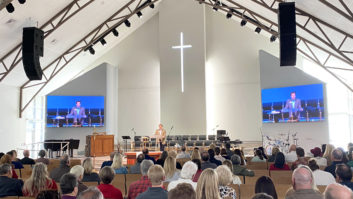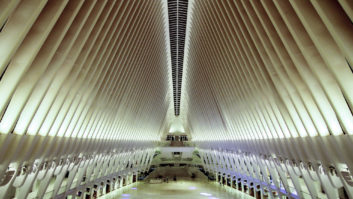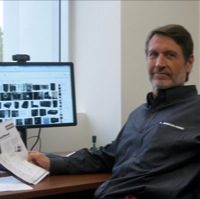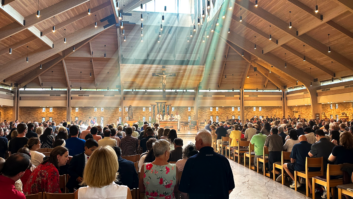The worship market is a paradox. In one way it has little to distinguish it from any other: the Dalai Lama goes on tour with a Meyer Sound MILO rig; the Fountain Of Life Centre in Florence, New Jersey uses Barix audio networking, intercom and automation; and every Sunday in St Peter’s Square, Rome, two giant Sony screens and countless EAW enclosures bombard the amassed crowd with dramatic scenes of the Mass drawing to a close inside the basilica – climactic organ music, close-ups of the Pontiff and a full audiovisual evocation of the Holy Trinity. (No, not Emerson Lake & Palmer. But it can sure remind you of prog-rock excess.)
But in other ways this market has characteristics that every installer will recognise as peculiar to worship facilities, and the industry is rapidly adjusting to them. On top of that, the whole edifice of spiritual communication is about to enter a new phase: one that will merge onsite reinforcement with global broadcast.
Heritage issues
Most notably in Europe, places of worship have a habit of being rather old. Immediately the installer is faced with issues of architectural heritage, sightlines and all the headaches of a fragile fabric with which to work.
In Installation Europe’s April issue, we reported on the Knight’s Temple near Fleet Street, London: built in 1185, it’s now a Grade I listed monument and has been a private chapel for the legal profession based at Temple for around 400 years. Indeed the bewigged congregation remains acutely aware of the Royal Charter that assigned the chapel to its members, who are said to be “perpetual guardians of the Knight’s Temple”. Not exactly a blank canvas, then.
When installer RG Jones was given the brief to put in a sound system recently, the priority was to fill the space with intelligible audio while ensuring this did not distract from the architecture – a frequently encountered set of guidelines in such circumstances.
So, firstly, RG Jones’s Geoff Sharp attempted to match the delicate vertical shape of the chapel’s Gothic columns with a Bose Panaray MA-12 line array, under proprietary digital control.
Secondly, each module was colour-matched to the stone and even hand-finished after installation to dissolve them into the surroundings as much as possible. It’s a solution increasingly repeated as monuments gain sound, and a sure sign that camouflage is becoming a key issue in product design.
But, as all lovers of Gregorian chant well know, the real meat of the problem in such spaces is reverb. At the Knight’s Temple, line array is seen as the best solution. According to Sharp: “The line array characteristics of a system of 10 Bose Panaray MA-12 loudspeakers bestow the linear consistency and control of sound coverage necessary within the sound-reflective environment of the church. The speakers feature a wide dispersion angle that works easily with the structural limitations of the stone columns.
“The round area, with its vast dome, has naturally impressive choral properties. It’s not an area that can be pushed in terms of sound level. It’s a very difficult dome, remarkably easy to excite if you start to drive the speakers with any real volume. So just two Panaray MA-12 modules serve that area, lifting the natural acoustic and volume to enhance the spoken-word projection.
“Throughout the rest of the church, the steady uniformity of sound level from the Bose MA-12s ensures a very simple system set-up. In the nave area, the main consideration was the high wooden surrounds of the pews, which could possibly have masked the sound while people were praying. As a counteractive measure the eight MA-12s that feed the area are positioned a little higher and angled slightly downwards.”
Let there be light
St Paul’s Cathedral in London could easily be considered a natural choice for some showcase architectural lighting, but it is hardly ripe for drilling in a series of cable runs. Speirs & Major Associates recently finished a complete re-lighting of the interior, and turned to Lutron’s lighting control technology to overcome several difficulties.
Mostly these centred on the classic house of worship brief: don’t show any cables; don’t interfere with broadcast RF; use the ancient wiring; and build a system to accommodate everything from daily services to royal weddings.
Enter Lutron’s Grafik 7000 Series lighting control system. It offers control of multiple zones via a user-friendly GUI, and allows careful use of RF systems for wireless control. There are four modes of operation accessed by two touchscreens, one in the North West Quarter gallery and one in the Great West entrance.
Global Mode allows building-wide presets to be activated, so providing most of the daily lighting requirements. Local Control Mode uses the localised remote-control system to change settings from specific locations. Theatrical Mode, meanwhile, uses a theatrical lighting console for manual control of pre-selected groups or individual circuits that will override underlying presets – handy for special events. Finally, Maintenance Mode is for overnight security, including safety from night-staff interference.
One clue to the future of discreet control is this use of RF lighting controls, which in the case of St Paul’s Cathedral was required to cut through up to 4ft of solid stone walls, ceilings and floors. Lutron’s Grafik Master is the RF control for the Grafik Eye and Integrale systems, and is linked to the Grafik 7000 control processor.
It took painstaking analysis of the site to ascertain the optimum transmitter-to-repeater coverage, causing Lutron sales director Bruce Griffin to comment: “Going from triforium level – the gallery above the arches of the nave – through to the cathedral floor, to operate lights in the crypt and gift shop, was no mean feat with such depths of stone and using RF technology.”
The other rapidly emerging trend in technology support for worship events concerns projection. Just as U2, Nelson Mandela or Manchester United will reinforce their every move on giant screens, ambitious religious organisations are adopting the same techniques for their own congregated followers. Hymns are captioned, background images are overlaid and show effects are applied as every detail of the service is beamed throughout the space.
Belfast’s Whitewell Metropolitan Tabernacle (pictured) lights the way with two Barco FLM R20+ projectors, augmented with Barco’s ScreenPro Presentation System. The SXGA+, 20,000 lumens, three-chip DLP FLM R20+ projector has output to outmuscle the bright environment of the church, with clearly legible image detail sourced from both the five-camera live mix and recorded footage.
Images are sent from the ScreenPro unit to the projectors via a DVI Matrix-Pro router and DVI-to-fibre extenders, providing full resolution along a cable run over 100m in length.
Community access
Once on screen, of course, the signal can be distributed anywhere. Whitewell’s system includes three ImagePro HD-SDI units, ready to convert scaled-down SDI and PAL versions for which, well, the sky is almost literally the limit.
According to Barco’s Peter Taylor, an increasing number of religious communities are turning into a combination of community centre and television station, building upon the televangelism phenomenon to fuse that technology with better and better sound and video reinforcement within the churches.
“The whole idea is that you may get a bit of the message while you’re drawn into this attractive world of entertainment technology,” he says, speaking from his US base.
“Young people are the target, so rock bands, video, pool tables, Saturday night services and even singles nights have been introduced! The audio is getting louder, everything goes into some kind of production switcher and it all gets fed to several screens. I recently did a Hindu temple with eight screens in it.
“It has started to go over to Europe, too. Maybe not in my parents’ local church in King’s Lynn, which I see them visit when I’m in the UK – and there’s nobody under 50 in there. England has a challenge: if most of the buildings are up to 900 years old, where do you put the technology? But churches are realising that they have to capture the youth. Across Europe the newly built ecclesiastical architecture is very much wired up.”
“Oh yes, it’s not just a church!” agrees David Webster of audio console manufacturer DiGiCo, whose business has boomed at installations such as the Resurrection Life Church in Michigan. “It really is the whole community, with sports centres, day-care centres, nurseries… you name it, they have it, and the donations are almost like a tax. On the back of that, the ‘Sunday’ side of it invests in huge amounts of state-of-the-art performance technology.
“The nearest equivalent in the UK would be somewhere like Kingsgate Community Church in Peterborough, which we supplied. Between services it’s rented out as a modern, multi-purpose venue to almost anyone, which of course brings more money back into the church itself.”
Global interest
The wealthy Christian bible belt of the US may have pioneered hi-tech holiness, but it certainly doesn’t have exclusive rights to it. Muslim communities in Europe are now getting in on the act, with some already proclaiming the advent of the electric mosque (see case study, page 37).
The key elements are fast, effective AV communication, appropriated for public service but channelled along the discrete lines of each sect. In many ways, the houses of worship themselves are the local satellites within overlaying networks of faith, each with their own needs but, potentially, all demanding more and more sophisticated installation technology.
The penetration of such technology deep into the worship market is evident in the modest surroundings of the First Larne Presbyterian Church in Northern Ireland, far away from medieval monuments or flashy televangelism.
At this level, any technology is likely to be met with some suspicion, but Larne has settled upon a subtle adaptation of conference-style AV that, according to Coleraine-based installer Light & Sound FX, is winning over converts in the local community.
“The churches are very organised and have dedicated committees for every function,” says Darren Gardiner of Light & Sound FX. “When they say the building will be accessible, for example, it most certainly is – right on the date and time you’ve agreed. It doesn’t always work like that with the city-centre entertainment business.”
At Larne the ceiling above the pulpit carries two KV2 Audio EX12s, while above the gallery at the back of the hall are two EX10s. These are active, and mixed from a Mackie SR32 placed on the front row of the gallery.
“We tend to use the SR32 in churches because it’s just so easy to operate,” says Gardiner. “It’s ideal in that budget bracket – very clearly laid out with a gentle sweep to the EQ that prevents an inexperienced user from radically altering things.”
Quality control
Quality is essential. “The front and back speakers are time-aligned via BSS Minidrive,” Gardiner adds, “and once they were in place and switched on, remarkably little tuning was required. That’s down to the sheer quality of the speakers. The alignment ensures that, when the minister speaks, it’s coming from the minister and not from a speaker above your head. They’re full-range, rolled off around 45Hz and EQ’d slightly around 10kHz and 250Hz-450Hz. That’s all the tweaking there is.”
Meanwhile, the microphones are all Sennheiser. “They may be slightly more expensive, but this is where the churches will spend money,” confirms Gardiner. “The cabling, for instance, is all Van Damme Blue Series multicores and Van Damme RGBHV video cable – real specialist cable, and not cheap.”
Equally effective are the PTZ dome cameras feeding the Kramer Electronics switcher and various screens. These are used for community announcements, biblical images, hymns and even PowerPoint sermons. Now that these features have won over the purists, there’s talk of video feeds into the community via CCTV, as well as CD and DVD spin-offs to support the ministry. Crucially, this has worked because of the subtle nature of the installation.
“With a nightclub you can put anything in and nobody really notices,” adds Gardiner, “but in a church there’s more time spent on attention to detail than anything else. You have to have it just so, with no loose ends – and, actually, it improves our standard of installation technique.”
As far as rational thought will allow, a house of worship is, in essence, a theatre. The same kind of magic has to happen. For this reason alone, professional contractors need to be involved as much as possible so that installation technology can be allowed to do what it does best in a rarefied acoustic space: suspend that disbelief.
The next phase, quite literally, will transmit the messages to a new, younger and much wider audience.





